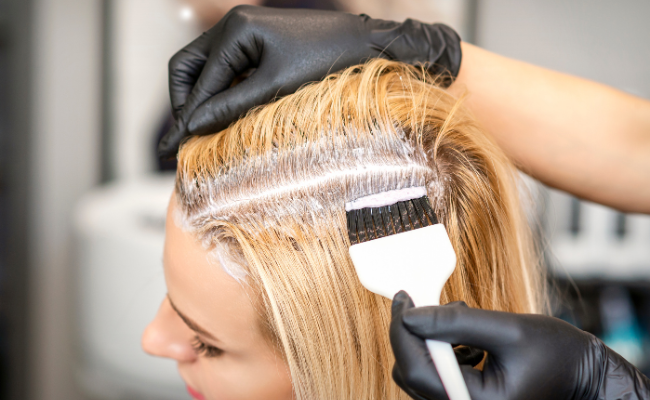How to Treat Hair Dye Allergy?
- October 12, 2023
- No Comments

What is Hair Dye Allergy?
Hair dye allergy arises from the immune system's adverse response to specific chemicals found in hair coloring products, such as paraphenylenediamine (PPD) and ammonia, both recognized culprits for inducing allergic reactions. The ensuing symptoms span from mild skin irritation to more pronounced manifestations, encompassing redness, itching, swelling, and, in extreme cases, difficulty breathing. Recognizing the signs promptly is crucial.
These hair coloring products encompass a diverse array of ingredients, potentially triggering scalp irritation and allergic responses. The intensity of symptoms varies, ranging from mild discomfort to more severe expressions, with onset sometimes taking up to 48 hours. For those seeking alternatives with potentially fewer irritants, delving into natural hair dyes emerges as a viable solution.
Why Does Hair Dye Allergy Occur?
Hair dye allergies occur when the immune system identifies certain chemicals in the hair dye as harmful and triggers an inflammatory response. PPD, a common ingredient in hair dyes, is a primary culprit for these reactions. The sensitivity to PPD varies from person to person, and some may develop an allergy after repeated exposure, while others may react after just one use. The ammonia present in many hair dyes can also contribute to allergic reactions.
How to Identify Hair Dye Allergy?
- Skin Irritation: The most common symptom is skin irritation, including redness, itching, and burning sensations on the scalp, face, or neck.
- Rash or Swelling: Allergic reactions may manifest as a rash or swelling, which can be localized or spread to other areas.
- Blistering: In severe cases, blisters may form, accompanied by oozing and crusting of the affected skin.
- Respiratory Issues: For some individuals, inhaling fumes from hair dye may cause respiratory issues, such as difficulty breathing or a tight chest.
- Anaphylaxis: In rare cases, a hair dye allergy can lead to anaphylaxis, a severe and potentially life-threatening allergic reaction that requires immediate medical attention.
Treatment Solutions for Hair Dye Allergy
- Cease Use Immediately: If you suspect a hair dye allergy, stop using the product immediately. The longer the exposure, the more severe the reaction can become.
- Rinse Thoroughly: Wash the affected area with mild soap and lukewarm water to remove any residual dye from the skin.
- Topical Steroids: Over-the-counter or prescription-strength topical steroids can help reduce inflammation and alleviate symptoms. Consult a healthcare professional for appropriate recommendations.
- Antihistamines: Oral antihistamines can provide relief from itching and help manage mild allergic reactions. Follow the recommended dosage and consult with a healthcare provider if symptoms persist.
- Cool Compresses: Applying cool compresses to the affected area can help soothe irritated skin and reduce swelling.
Benefits of Seeking Prompt Treatment
- Preventing Escalation: Prompt treatment helps prevent the escalation of symptoms. Mild reactions can worsen if not addressed promptly, leading to more severe discomfort and complications.
- Reducing Discomfort: Timely intervention can significantly reduce the discomfort associated with a hair dye allergy, making the recovery process more manageable.
- Preventing Spread: Taking immediate action can prevent the spread of the allergic reaction to other areas of the body and minimize the risk of complications.
- Avoiding Long-Term Effects: Swift treatment helps avoid potential long-term effects of severe allergic reactions, such as scarring or changes in skin pigmentation.
- Medical Evaluation: Seeking medical attention ensures a proper evaluation of the allergic reaction. In some cases, a healthcare professional may prescribe stronger medications or recommend additional measures to manage symptoms effectively.
Preventive Measures for Future Use
- Patch Test: Always conduct a patch test before using a new hair dye product. Apply a small amount of dye to a small area of skin and wait for 48 hours to check for any adverse reactions.
- Choose Allergy-Friendly Products: Opt for hair dye products labeled as hypoallergenic or specifically formulated for sensitive skin. These products often contain fewer harsh chemicals.
- Natural Alternatives: Consider using natural alternatives for hair coloring, such as henna or vegetable-based dyes, which are less likely to cause allergic reactions.
- Consult a Dermatologist: If you have a history of skin allergies, consult a dermatologist before using hair dye. They can provide personalized recommendations based on your skin type and sensitivity.
- Limit Exposure: Minimize the frequency of hair dye use to reduce the risk of developing an allergy. Consider alternatives like highlights or lowlights to achieve desired effects without full-color application.
Comments (0)